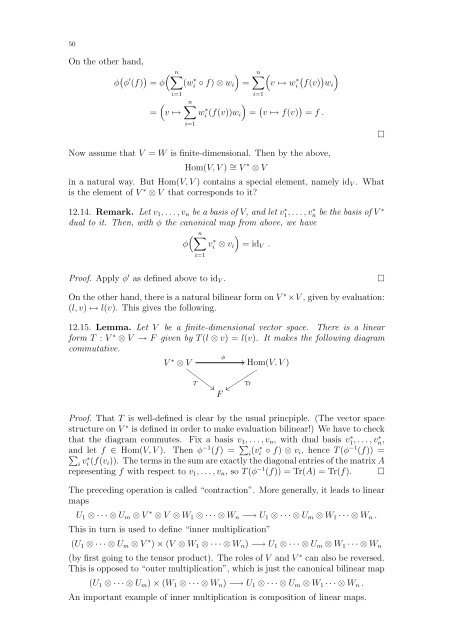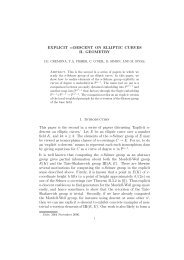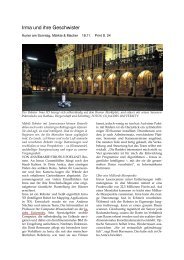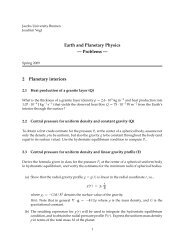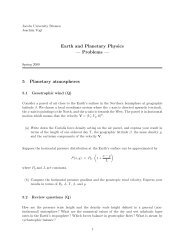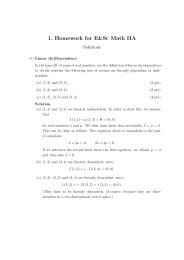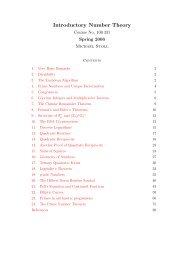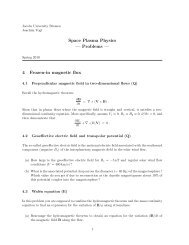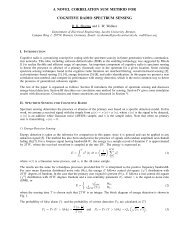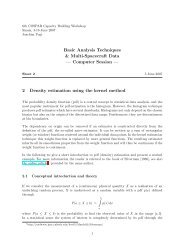Linear Algebra II (pdf, 500 kB)
Linear Algebra II (pdf, 500 kB)
Linear Algebra II (pdf, 500 kB)
Create successful ePaper yourself
Turn your PDF publications into a flip-book with our unique Google optimized e-Paper software.
50<br />
On the other hand,<br />
φ φ ′ (f) n = φ<br />
=<br />
i=1<br />
<br />
v ↦→<br />
(w ∗ i ◦ f) ⊗ wi<br />
n<br />
i=1<br />
w ∗ i (f(v))wi<br />
<br />
=<br />
n <br />
i=1<br />
v ↦→ w ∗ i<br />
f(v) wi<br />
<br />
= v ↦→ f(v) = f .<br />
Now assume that V = W is finite-dimensional. Then by the above,<br />
Hom(V, V ) ∼ = V ∗ ⊗ V<br />
in a natural way. But Hom(V, V ) contains a special element, namely idV . What<br />
is the element of V ∗ ⊗ V that corresponds to it?<br />
12.14. Remark. Let v1, . . . , vn be a basis of V, and let v∗ 1, . . . , v∗ n be the basis of V ∗<br />
dual to it. Then, with φ the canonical map from above, we have<br />
n <br />
φ<br />
= idV .<br />
i=1<br />
v ∗ i ⊗ vi<br />
Proof. Apply φ ′ as defined above to idV . <br />
On the other hand, there is a natural bilinear form on V ∗ ×V , given by evaluation:<br />
(l, v) ↦→ l(v). This gives the following.<br />
12.15. Lemma. Let V be a finite-dimensional vector space. There is a linear<br />
form T : V ∗ ⊗ V → F given by T (l ⊗ v) = l(v). It makes the following diagram<br />
commutative.<br />
φ<br />
V ∗ ⊗ V<br />
<br />
<br />
T <br />
<br />
F<br />
<br />
Tr<br />
Hom(V, V )<br />
Proof. That T is well-defined is clear by the usual princpiple. (The vector space<br />
structure on V ∗ is defined in order to make evaluation bilinear!) We have to check<br />
that the diagram commutes. Fix a basis v1, . . . , vn, with dual basis v ∗ 1, . . . , v ∗ n,<br />
and let f ∈ Hom(V, V ). Then φ −1 (f) = <br />
i (v∗ i ◦ f) ⊗ vi, hence T (φ −1 (f)) =<br />
<br />
i v∗ i (f(vi)). The terms in the sum are exactly the diagonal entries of the matrix A<br />
representing f with respect to v1, . . . , vn, so T (φ −1 (f)) = Tr(A) = Tr(f). <br />
The preceding operation is called “contraction”. More generally, it leads to linear<br />
maps<br />
U1 ⊗ · · · ⊗ Um ⊗ V ∗ ⊗ V ⊗ W1 ⊗ · · · ⊗ Wn −→ U1 ⊗ · · · ⊗ Um ⊗ W1 · · · ⊗ Wn .<br />
This in turn is used to define “inner multiplication”<br />
(U1 ⊗ · · · ⊗ Um ⊗ V ∗ ) × (V ⊗ W1 ⊗ · · · ⊗ Wn) −→ U1 ⊗ · · · ⊗ Um ⊗ W1 · · · ⊗ Wn<br />
(by first going to the tensor product). The roles of V and V ∗ can also be reversed.<br />
This is opposed to “outer multiplication”, which is just the canonical bilinear map<br />
(U1 ⊗ · · · ⊗ Um) × (W1 ⊗ · · · ⊗ Wn) −→ U1 ⊗ · · · ⊗ Um ⊗ W1 · · · ⊗ Wn .<br />
An important example of inner multiplication is composition of linear maps.


